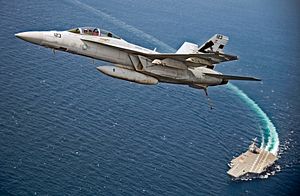The nuclear-powered Gerald R. Ford-class aircraft carrier USS Gerald R. Ford (CVN-78), the lead ship of the United States’ latest class of carriers, has successfully put its new flight deck technology to the test less than a week after U.S. President J. Donald Trump commissioned the U.S. Navy’s most expensive warship ever.
According to the commander of U.S. Naval Air Forces Atlantic, the USS Gerald R. Ford launched and recovered its first fixed-wing aircraft, a F/A-18F Super Hornet, off the coast of Virginia on July 28 using the ship’s electromagnetic launch system (EMALS) to launch the aircraft from catapult and the advanced arresting gear (AAG) system to land the fighter jet on the Ford’s flight deck.
Both flight deck systems have been plagued with difficulties during their development phase. General Atomics’ EMALS system was also subject to criticism from Trump, who voiced his preference for the ship to be retrofitted with a steam-powered launch and recovery system and abandon electromagnetic catapults overall.
“I said what system are you going to be – ‘Sir, we’re staying with digital [EMALS].’ I said no you’re not. You going to goddamned steam, the digital costs hundreds of millions of dollars more money and it’s no good,” Trump told Time Magazine in an interview on May 11. The successful completion of four arrested landings and catapult starts on July 28 appears to have vindicated the new technology, at least in the eyes of U.S. Navy officials.
“Today, USS Gerald R. Ford made history with the successful landing and launching of aircraft from VX-23 using the AAG and EMALS,” said Admiral Phil Davidson, the commander of U.S. Fleet Forces. “Great work by the Ford team and all the engineers who have worked hard to get the ship ready for this milestone,” he added.
The AAG system has primarily been designed to allow for the arrestment of a wider range of aircraft and reduce the stress on airframes during landing operations. It requires less manpower to handle than previous designs. Conversely, the EMALS system features a higher-launch energy capacity, purportedly increasing sortie rates by one-third when compared to the Nimitz class while also reducing the so-called fatigue impact load to aircraft.
Like the AAG, the EMALS system also contains improvements in system maintenance and overall increased reliability and efficiency. “EMALS is designed to expand the operational capability of the Navy’s future carriers to include all current and future planned carrier aircraft — from lightweight unmanned aircraft to heavy strike fighters,” according to a U.S. Navy statement.
The U.S. Navy also recently completed testing on an EMALS software fix that will allow the heaviest aircraft to take off with less stress to the airframe, USNI News reports based on information supplied by the Naval Air Systems Command.
Next to the new AAG and EMALS flight deck systems, the USS Gerald R. Ford features a host of other unproven systems, including two main turbine generators, a new dual-band radar system, and advanced weapons elevators.
Given the many unproven systems, the U.S. Government Accountability Office (GAO) expects the ship not to be operationally deployed for at least four years. The “incomplete work will be completed over the course of more than four years and is expected to cost nearly $780 million,” the GAO noted in a report released in July. The U.S. Navy intends to induct a fleet of up to ten Ford-class aircraft carriers in the coming decades with the USS John F. Kennedy (CVN 79) expected to be commissioned in 2020.
































